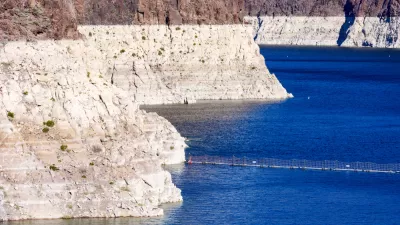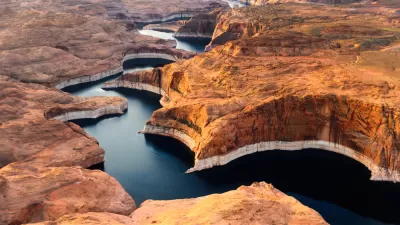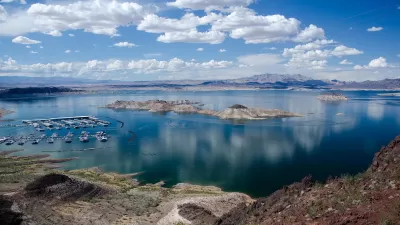In the throes of a historic megadrought, three Southwestern states will make deep reductions in their water usage to preserve diminishing resources.

After the federal government declared a historic water shortage for Lake Mead this summer, California, Arizona, and Nevada have agreed to reduce the amount of water they procure from the Colorado River in an effort to save one million acre-feet from leaving the reservoir in the next two years. As reported by Jaweed Kaleem and Ian James, "Water agencies in Southern California, Arizona and Nevada agreed to find water savings from various sources and split the $200-million cost with the federal government."
As water levels in Lake Mead and Lake Powell, the Colorado River's other major reservoir, continue to decline, experts say states may have to make even deeper cuts to adapt to a future with less water. "The new deal, called the 500+ Plan, nearly doubles the water reductions that the three states — which make up the lower basin of the river — negotiated in 2019 under what is called the drought contingency plan." The deal is a step toward correcting over-allocated water rights, but environmental groups say upriver states must also reduce their usage. Meanwhile, Utah is proposing a controversial new pipeline that would draw more water to that state.
Local tribes hold 20 percent of water rights and have contributed crucial efforts, yet have remained largely unrecognized in official negotiations. During this latest round of agreements, leaders from the Gila River Indian Community and the Colorado River Indian Tribes were present as signatories.
FULL STORY: California, Arizona and Nevada agree to take less water from ailing Colorado River

Alabama: Trump Terminates Settlements for Black Communities Harmed By Raw Sewage
Trump deemed the landmark civil rights agreement “illegal DEI and environmental justice policy.”

Study: Maui’s Plan to Convert Vacation Rentals to Long-Term Housing Could Cause Nearly $1 Billion Economic Loss
The plan would reduce visitor accommodation by 25% resulting in 1,900 jobs lost.

Why Should We Subsidize Public Transportation?
Many public transit agencies face financial stress due to rising costs, declining fare revenue, and declining subsidies. Transit advocates must provide a strong business case for increasing public transit funding.

Wind Energy on the Rise Despite Federal Policy Reversal
The Trump administration is revoking federal support for renewable energy, but demand for new projects continues unabated.

Passengers Flock to Caltrain After Electrification
The new electric trains are running faster and more reliably, leading to strong ridership growth on the Bay Area rail system.

Texas Churches Rally Behind ‘Yes in God’s Back Yard’ Legislation
Religious leaders want the state to reduce zoning regulations to streamline leasing church-owned land to housing developers.
Urban Design for Planners 1: Software Tools
This six-course series explores essential urban design concepts using open source software and equips planners with the tools they need to participate fully in the urban design process.
Planning for Universal Design
Learn the tools for implementing Universal Design in planning regulations.
Caltrans
Smith Gee Studio
Institute for Housing and Urban Development Studies (IHS)
City of Grandview
Harvard GSD Executive Education
Toledo-Lucas County Plan Commissions
Salt Lake City
NYU Wagner Graduate School of Public Service





























